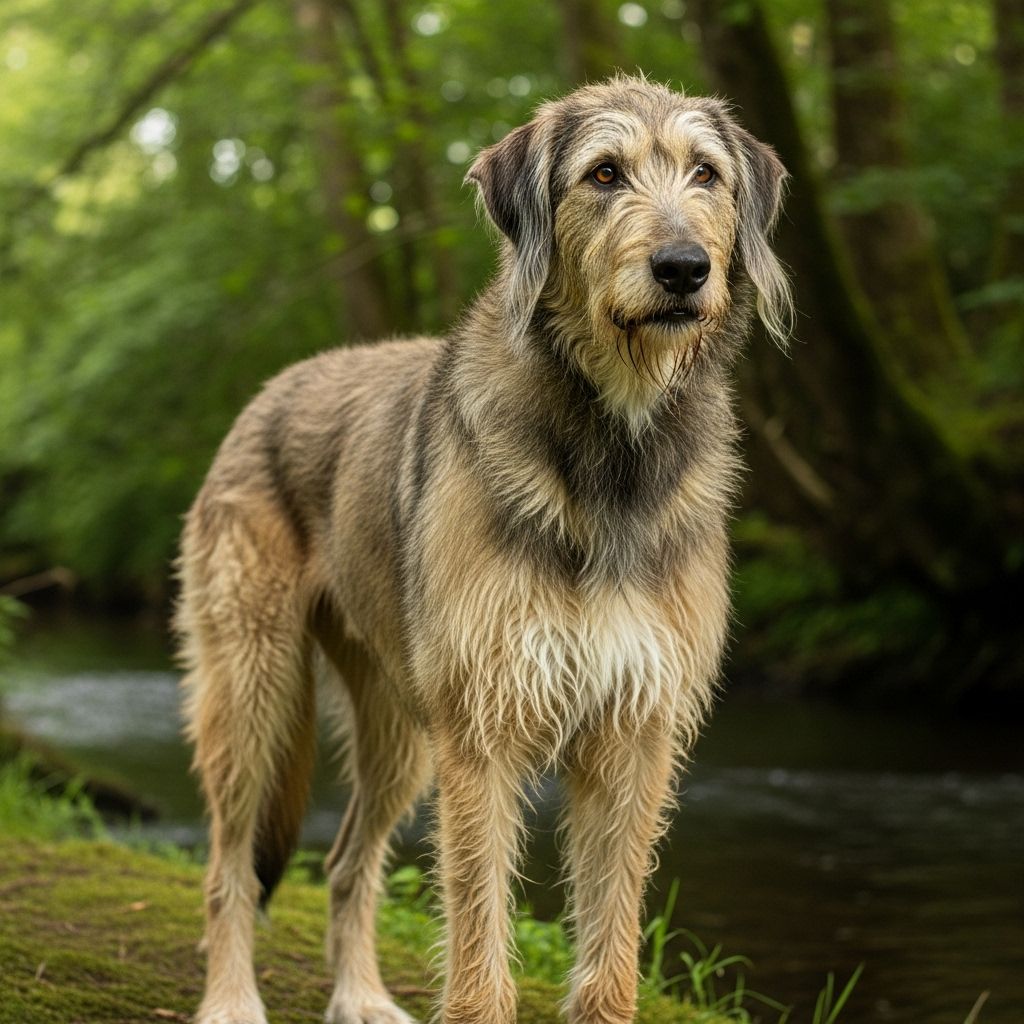Otterhound: 7 Fascinating Facts Every Dog Lover Should Know
Buoyant webbed paws and melodious bays showcase this endangered breed’s whimsical charm.

7 Fascinating Facts About the Otterhound: A Rare Canine Treasure
The Otterhound is a breed that intrigues dog lovers around the world with its distinctive look, quirky habits, and storied past. With fewer than 1,000 left globally, the Otterhound is among the world’s most endangered dog breeds. This article delves into what sets the Otterhound apart, spotlighting history, personality, unique water-loving features, and their critical conservation status. Whether you’re a dog enthusiast, a potential Otterhound owner, or simply curious, these seven facts will illuminate why Otterhounds are so exceptional.
1. An Ancient Hunter With a Distinct Mission
The history of the Otterhound stretches back nearly a millennium. References to “otter dogges” date as early as the 1100s in England, but the Otterhound as we know it didn’t emerge until the late eighteenth and early nineteenth centuries. Originally developed to hunt river otters and protect fish stocks in British rivers, the Otterhound’s breeding combined the capabilities of several formidable canines: the keen nose of the Bloodhound, stamina of the Foxhound, strength in water like the Newfoundland, and the persistence of a Beagle.
- Purpose-bred: Their job required incredible scent-tracking on both land and water, a courageous spirit, and physical power.
- Legal changes: Once otters became protected in Britain in the late 1970s, organized otter hunting ceased, pushing the Otterhound into new, more domestic roles.
- Historic packs: At their peak, several packs existed across the UK; today, only a handful of purebred packs remain.
2. Unique Features: Built for Water and Land
The Otterhound’s unmistakable appearance isn’t just for show—it’s a collection of adaptations evolved for a hybrid life as a scenthound on dry land and an aquatic tracker in rivers and lakes.
- Rough Double Coat: Otterhounds have a shaggy, waterproof topcoat and a woolly, insulating undercoat. This not only keeps them dry while swimming but also warm in cold waters.
- Webbed Feet: Unlike most dogs, Otterhounds have large, substantial feet with pronounced webbing between the toes—a true swimmer’s tool for propulsion and stability in swift-running rivers.
- Imposing Size: Males often weigh up to 115 pounds, females around 80 pounds. Their large, rectangular bodies provide the strength and endurance for extended work outdoors.
- Distinctive Head: The Otterhound’s head is broad, defined by a prominent beard and mustache, with low-set, pendulous ears and a noble, expressive gaze.
3. An Endangered Breed Facing Uncertain Future
Despite their legacy and lovable traits, Otterhounds are rare—critically so. There are fewer than 350 Otterhounds in the United States and Canada, and fewer than 1,000 worldwide. Their endangered status is due to a combination of complex breeding needs, lack of widespread awareness, and the breed’s original working purpose becoming obsolete.
- Low numbers: Ranked among the world’s rarest dog breeds.
- Conservation efforts: Enthusiasts, breed clubs, and a network of dedicated breeders strive to preserve healthy, diverse Otterhound populations—often tracking lineages carefully.
4. Affectionate Clowns With Independent Spirits
Known as the comedians of the hound world, Otterhounds are prized for their warm temperament and boisterous, playful nature. They possess a clownish humor and a penchant for mischief, keeping families entertained and on their toes.
- Family companions: Gentle and loving with people, often known to ‘lean’ affectionately into family members.
- Sociable yet independent: Otterhounds are pack dogs and enjoy the company of other dogs, household pets, and children—though their size and exuberance may be overwhelming for toddlers.
- Intelligent and stubborn: While trainable, Otterhounds often have an independent streak, sometimes choosing their own amusements if left to their own devices.
5. A Nose for Adventure: Scent and Sound
The Otterhound’s extraordinary sense of smell is legendary—second only to the Bloodhound in the canine world. Their keen noses enable them to follow cold scents over land and water, making them unrivaled trackers. But their vocalizations are equally remarkable.
- Deep bay: Otterhounds don’t just bark—they ‘sing’, with a deep, melodious bay carrying for great distances. Historically, packs created harmonious ‘music’ during hunts, a source of pride for hunters and a quirk for modern owners.
- Talkative at home: Many Otterhounds mutter, groan, grunt, sigh, or join in with singing—sometimes providing an ongoing canine commentary at home.
6. Quirky Drinking Habits and Water Play
If you ever spot an Otterhound taking a drink, you’ll likely notice one of their most unusual (and endearing) quirks: they love to submerge their nose—or even their whole head—into the water dish rather than lapping neatly at the surface.
- Playful approach: Otterhounds often slosh water, creating puddles around water bowls as they drink. Their love of water goes beyond just hydration—they delight in ponds, streams, and even bathtubs.
- Mess makers: Expect wet beards and occasional splashing—these dogs are as joyful in water as they are on dry land.
7. Minimal Grooming, Maximum Shedding
The Otterhound’s coat may look unkempt but is surprisingly low-maintenance. While they do shed their shaggy fur, their hair rarely needs to be clipped, and professional grooming is unnecessary.
- Weekly brushing: Simple combing and brushing once a week is enough to prevent mats and tangles. Their resilient coat dries quickly after a swim or bath.
- Shedding: Otterhounds do shed, but many owners find the shedding less troublesome than with many other breeds.
Otterhound At A Glance
| Feature | Description |
|---|---|
| Breed Group | Hound |
| Origin | United Kingdom |
| Weight | 80–115 pounds |
| Height | 24–27 inches |
| Coat | Rough, double; water-repellent |
| Lifespan | 10–13 years |
| Temperament | Affectionate, independent, humorous, intelligent, sociable |
| Special Features | Webbed feet, deep melodious bay, exceptional scent ability |
| Status | Critically Endangered |
How to Care for an Otterhound
Otterhounds make wonderful pets given the right lifestyle and environment. Their large size, high energy, and need for mental stimulation are important considerations for any potential owner.
- Exercise: Otterhounds thrive on daily walks, swims, and free time in securely fenced outdoor areas. Their hunting roots mean they often love sniffing, tracking, and games that challenge their brilliant noses.
- Companionship: They prefer not to be left alone for long and are happiest as part of an active household or with other animal companions.
- Training: Positive, patient methods are crucial to unlocking cooperation—Otterhounds are smart, but stubborn.
- Space: Due to their size and energy, apartment living can be a challenge unless matched with ample outdoor time.
Frequently Asked Questions About the Otterhound
Q: Are Otterhounds good with children and other pets?
A: Yes, Otterhounds are friendly and sociable, making them wonderful companions for children and other pets. However, their size and energy mean they should be supervised around small children and introduced properly to household animals.
Q: Do Otterhounds need a lot of grooming?
A: Otterhounds require only basic grooming. Weekly combing and brushing keep their coats manageable, and shedding tends to be moderate. Their coat does not need to be trimmed, and professional grooming isn’t necessary.
Q: Are Otterhounds noisy?
A: Otterhounds are vocal dogs that enjoy expressing themselves with deep bays, groans, and even ‘singing’. While many owners find this endearing, their voices can carry, so training and considerate placement in residential areas are recommended.
Q: How rare is the Otterhound?
A: The Otterhound is among the most endangered dog breeds in the world, with fewer than 1,000 individuals globally. Responsible breeding and conservation are crucial to the survival of this unique breed.
Q: Do Otterhounds make good apartment dogs?
A: Due to their size and activity level, Otterhounds do best in homes with yard space and active owners. Apartment living may be difficult unless matched with plenty of outdoor exercise and mental stimulation.
Final Thoughts
The Otterhound is a one-of-a-kind companion—boisterous, affectionate, and rooted in a rich history that stretches back centuries. Their unique looks, powerful swimming abilities, clownish personalities, and gentle hearts make them a joy for the right families. Sadly, with their endangered status, new owners shoulder the responsibility of not just enjoying their presence but also helping preserve a living treasure for future generations.
References
- https://www.otterhounduniversity.com/breed-standards.html
- https://www.wisdompanel.com/en-us/dog-breeds/otterhound
- https://www.akc.org/expert-advice/lifestyle/instead-designer-breed-otterhound/
- https://www.akc.org/expert-advice/lifestyle/7-facts-about-the-otterhound/
- https://en.wikipedia.org/wiki/Otterhound
Read full bio of Srija Burman












